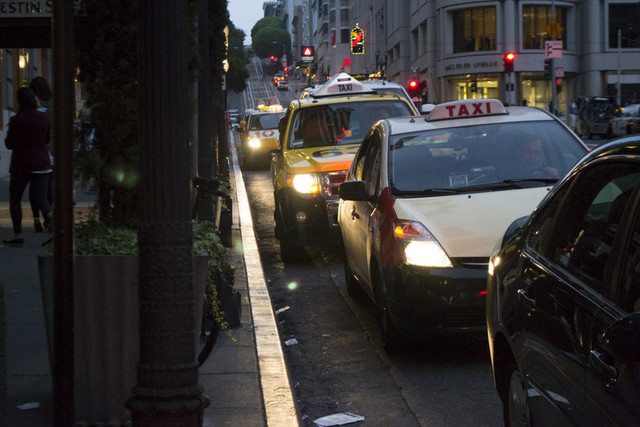That's a concern because the inaccessibility of ride-service vehicles, which are, after all, just drivers' personal cars being used to transport paying passengers, has been an issue. The accessibility plans that ride-service companies were required to file by the California Public Utilities Commission have so far been on the thin side. (Here are Uber's and Lyft's.) Updates on these plans are due on Friday.
Toran said that in response to the severe decline in ridership, the city's taxi division is waiving certain fees, like the one for a driver application, and reducing others, like the fee for medallion renewal.
Toran did indicate one sign of progress for those who have been pushing the industry to modernize: Eighty percent of taxis in the city are now using Flywheel, an app-based hailing tool that is similar to those of the ride services.
An alternative app, Curb, is used by 60 percent of cabs. The response time for taxis on Flywheel has been just 3.5 minutes, a significant development in light of the recent paper from UC Berkeley that found a marked superiority in the time ride-service vehicles responded to calls as opposed to taxis.
The increased use of apps by the city's taxis wasn't good enough, though, for SFMTA board member Malcolm Heinicke. He wasn't happy that the rate of use wasn't 100 percent.
"Why aren't they all on one of those apps ... and why aren't we mandating that they all be on one of those or a similarly widespread app?" he asked. "We're in a situation of catch-up here. ... I think the public needs to know that there are these apps out there, the public needs to know that these response rates exist.
"Why aren't we mandating they all be on an app the way we would have mandated they all be on a sufficiently large radio network back in the last generation of taxi service?"
Toran said she agreed it was a good idea to require that cabs use apps. "It's the new reality," she said.
Longtime Cab Driver Still Surviving But Considering Move to Uber
I asked John Han, a veteran San Francisco cab driver and keen observer of the industry whom we've been talking to on this story, how his income has held up lately, and what his plans are. Last year he told us he tried to make the switch to UberX, Uber's ride-service division, but aborted the attempt after he failed to find an insurance company that would cover his car.
Han said he was still hanging in there, despite a drop in the last six months or so. "I have noticed a decline in my take-home pay, but I'm making enough to not have to think of doing anything drastic," he said. "I'm just making a little less per shift."
He did say, however, that he knows cab drivers who are complaining their income has been cut in half.
I wondered if in light of AB2293, which would expedite the creation of insurance policies, not in existence now, specifically for ride-service drivers, whether he would again consider switching to a ride service. He said he would:
"When there's total transparency, when I can call an insurance company and say, 'C an you give me the right kind of policy for this kind of work?' and they know it’s an Uber or Lyft vehicle, that’s when i would say, 'Yeah, i think I’m going to do it.' "
But Bill Clark, another longtime cab driver who hit a similar brick wall on insurance when he considered switching to UberX, said he wouldn't try again, even though his income has dropped by about a third over the last two years. Clark said Uber's refusal to cover the accident in San Francisco in which an UberX driver hit and killed a 6-year-old girl has put him off the company for good.
"I don't want anything to do with them," he said.
You can watch the presentation on the status of the taxi industry in San Francisco below:
